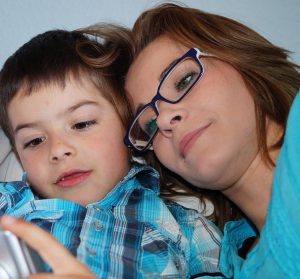How to Keep School Rhythm and Routines for Young Children at Home
 As schools shift to remote learning models for the foreseeable future, parents and caregivers are finding themselves in a new role—that of the school co-teacher. Though parents are naturally a part of their children’s ongoing education, co-teaching is a new role for many of them.
As schools shift to remote learning models for the foreseeable future, parents and caregivers are finding themselves in a new role—that of the school co-teacher. Though parents are naturally a part of their children’s ongoing education, co-teaching is a new role for many of them.
Beth O’Brien, head of early childhood at New Canaan Country School in New Canaan, Connecticut, offers her advice on how parents and caregivers can best provide hour-to-hour care.
The General Approach
Student well-being is our priority. For three-year-old to six-year-old students, daily points of connection with their school teachers will be most important. Whether the method is digital (email, video) or physical (material packets for pick-up, mailed letters), these connections will need to be mediated by parents or caregivers. Short greetings—which can be text, audio, video or some hybrid of the formats—can be followed by invitations to and ideas for follow-up engagement with a grownup at home.
We have messaged the following to teachers, and we believe the same should be true of parents and caregivers who are asked to be a bigger part of their children’s formal education than they may feel prepared to do:
1. Competency will build over time. Give yourself time and space to improve in your role as your child’s instructor, and give your child time and space to develop as an at-home learner.
2. Everyone has permission to embrace a “beginner’s mindset.” To be adaptable, flexible, and willing to make mistakes. A sense of humor will be helpful here as well.
3. Young children are naturally inquisitive and driven to explore, discover, tinker and test. They are always learning. This shift to ‘school at home’ will offer you a chance to observe that learning in a new way.
4. Ease into things. The first 5 days don’t need to look like the next 5 which don’t need to look like the 5 or 10 after that.
5. Prioritize what you need to run your household and remain holistically healthy. Work, childcare, meals, checking in on other family members, etc. will require your attention.
6. Focus on self care. It’s like the oxygen mask in the plane analogy — make sure yours is functioning before helping others.
Preparing a Setting at Home
Here are some ways to prepare space and practice behaviors for follow-up engagement:
Set up an indoor space where learning activities happen in your home. Collaborate with your child about where “school will happen” and what materials will be needed. Set up a place where your child can reach needed supplies such as paper, a clip board, scissors, pencils, crayons, tape, etc.
Children love to be helpers. They want to contribute, and they thrive when they feel a sense of accomplishment. After watching a teacher video or reading a prompt, invite your child to help you collect materials needed for the activity.
As children are working, hold space in your own schedule just for them. Describe what you see. Focus on effort. Name progress. Ask questions.
- Be present: Proximity is our most powerful gift. An encouraging smile or a supportive nod will be reassuring.
- Describe what you see: You found all the blue and green unifix cubes and now you’re making a pattern. That block building is tall. You used a lot of purple today. You did it!
- Focus on effort: You kept going even when you were frustrated. You stuck with it when you were unsure.
- Name progress: You’ve done three. You have two more to go.
- Ask questions: Tell me about it. I wonder what will happen next? What’s your idea?
If possible, document your child’s work. Take a photo. Record a short video. Keep a journal of what you are observing.
Consider transitions. Flow, pacing, and movement are vital to a young child’s learning. After a focused activity, have children move: run around outside, do flips on the couch, engage in self-directed play.
Rhythm and Routine at Home
Consider the power of routine and rhythm as an anchor to your child’s “school days.” Create a daily schedule based on what the school teacher sends (whether the message is daily, every other day, weekly, etc.). Have your child help draw pictures or write labels so they can see the plan for the day. Provide as many links between home and school as you can to help your child orient and activate prior knowledge of classroom routines.
Here is a home “school schedule” to consider:
- Breakfast followed by morning routine: get dressed, brush teeth, complete morning chores, etc.
- Self-directed play: mirrors morning arrival choice time
- Lesson & follow-up
- Snack & Outdoor time
- Self-directed play or set materials from a teacher activity prompt for the child to explore and create: mirrors daily choice time
- Daily read-aloud video
- Lunch
- Quiet Time: audio books, quiet music, rest: mirrors a familiar routine from school
- Specialist Video and activity prompt
- Outdoor time
- Morning Meeting video: greeting, do-with-me movement activity, ideas for the day
Online Curricular Resources
These are just a few of the many resources that parents and caregivers can look to in support of their children’s experiences.
- Art & Play Activity Guide: A weekly art and play activity guide for learning at home for children ages 3-8.
- Other Goose: Homeschooling resource for families of children 2-6 year olds focusing on open-ended discovery.
- Sparkle Stories: Audio stories and activities for children ages 3-12
- Nature on PBS: Documentaries that illuminate the wonder and beauty of the natural world
- WOW in the World: NPR Podcast for curious children, ages 5-12 and their grown-ups
- TinkerLab: Art, science and tinkering guides for parents with children ages 2-12
Excerpted from “How to Keep School Rhythm and Routines for Young Children at Home” in EdSurge. The full article offers suggestions for home school activities, educator guidance, and parenting resources for COVID-19.
Source: EdSurge | How to Keep School Rhythm and Routines for Young Children at Home, https://www.edsurge.com/news/2020-03-17-how-to-keep-school-rhythm-and-routines-for-young-children-at-home | © 2011-2020 EdSurge Inc.
Do you need someone to talk to? CHC can help. We invite you to call or email our Care Coordinators at 650.688.3625 or careteam@chconline.org to set up a free 30-minute consultation.




